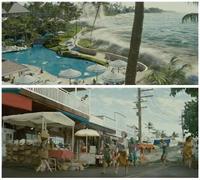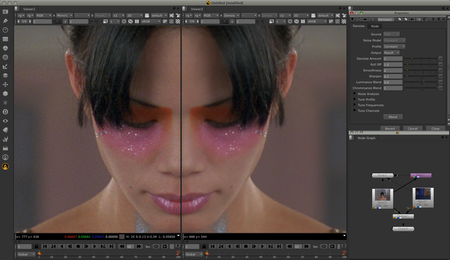July 2011 Archives

Last night I attended the Foundry's Midsummer Night Event of Nuke and Mari at Dreamworks in Glendale. After a harrowing hours drive from Venice to Glendale on a motorcycle, I arrived on the dot at 7pm, just as the event was starting. Let me tell you, the 10, 405, 101, and 134 at 6:30 is a PITA. For some reason, everyone was out there. It took Gresham two hours to drive from Venice to Glendale, and he arrived the same time I did. Any way, on to the presentation.
After a brief introduction about the event and Dreamworks, our MC introduced Kevan O'Brien, Creative Specialist at the Foundry, to talk about the new cool stuff in NukeX 6.3. While I've played intermittently with the beta, I haven't gotten my hands dirty on it since I've been deep in production on a commercial using 6.2. Some of the shiny new features include a particle system, integration with Mari, enhanced spline and gridwarp tools, improved degraining (which I had the chance to use extensively during Real Steel), audio guides within Nuke, a Planar tracker, and some other niceties. But don't let me tell you, read the NukeX 6.3v1 Release Notes. Each presenter had about 20 minutes to talk about their particular piece.

From there, Joe Farrell from Scanline VFX took over. He and I worked together at Digital Domain, as well as on previous projects in Vancouver, at least a decade ago. He presented a well documented case study of the work Scanline VFX did on Hereafter. I had a great experience with Clint Eastwood on Flags of our Fathers, and it looks like Joe had the same on this film. Eastwood regularly works with the same crew. Joe presented the making-of certain sequences in the film, predominately the beginning tsunami sequence, which is impressive in it's own right. The techniques presented were very similar to how Digital Domain works. This makes sense, as there is a lot of cross-pollination of ideas and workflow throughout the industry. A lot of Scanline's custom tools that I saw in the presentation we also have at Digital Domain, they are slightly different, but do accomplish the same goal.
Jack Greasley, Mari Product Manager, took over next as he introduced the new Mari 1.4 and the just released Mari 1.3. I've never used Mari before, but the technology behind it is quite nice, and the Nuke>Mari bridge that they showed on stage is sure to help out in the future. Brandon from Bad Robot describes it in more detail in the next presentation. I was introduced to ptex for the first time as well, and while it's been around for a while, I never use it in my day to day compositing life. It looks extremely promising.

Super 8 Bad Robot Productions Supervisor Brandon Fayette was there to talk about the Nuke>Mari bridge, and let me tell you, it's definitely something that I see being used for future environmental projection and matte painting work. He also showed the new Denoise tool in NukeX 6.3 with plate footage from Super 8, and that got a lot of cheers and wows from the audience. It is as awesome as he made it out to be. We were using the alpha for a long time, and the same one he was using, I'm sure. After his entertaining presentation, the floor was opened up for questions, and from there, mingling!
I met a bunch of people that I worked with in the past who were there to see what was new. Gresham, Howard, Martin, Emi, and Rohini were but a few! After a few words of where everyone was at and what they were doing, I did the drive back home in 20 minutes. Not too bad when there's no traffic.
